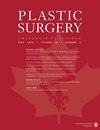隆胸手术中肥大乳头的治疗
IF 0.7
4区 医学
Q4 SURGERY
引用次数: 0
摘要
背景:乳头与乳晕和乳房不成比例,会给患者带来生理和心理问题。在进行隆胸手术时,乳头会被植入的假体向前凸出,造成相对于乳晕更突出、更大的视觉效果。成功的乳头缩小术应该能够缩小乳头的直径和凸出部分,以达到良好的美观效果,同时保留乳头的敏感和哺乳功能。研究目的本研究的目的是描述我们在隆胸手术中采用的乳头缩小技术和效果。研究方法我们对阿根廷布宜诺斯艾利斯德意志医院(Deutsches Hospital)整形外科在 2016 年 1 月至 2022 年 6 月期间同时实施隆胸术和乳头缩小术的患者进行了回顾性队列研究。我们的技术包括环形切除乳头基底皮肤,然后楔形切除乳头下部。通过对比术前和术后照片来评估手术效果。结果我们共纳入了 17 名患者。没有患者出现乳头坏死、伤口裂开、增生性瘢痕或永久性感觉缺失。术后随访无法评估哺乳情况。所有患者的美容效果均令人满意。结论:我们介绍了我们的手术技术,该技术可以治疗肥大的乳头,独立解决前后投影和直径问题。反过来,它还保留了感官。在乳头基底及其下表面植入疤痕,疤痕不明显,美观效果好,患者满意度高。证据等级:四级,回顾性队列。本文章由计算机程序翻译,如有差异,请以英文原文为准。
Treatment of the Hypertrophic Nipple in Breast Augmentation
Background: Disproportionately large nipples with respect to the areola and the breast can result in physical and psychological problems for the patient. When a breast augmentation is performed, the nipple is projected forward by the implant, creating an optical appearance of being more projected and bigger in size with respect to the areola. A successful nipple reduction should be able to reduce its diameter and projection to achieve a good esthetic result, preserving its sensitive and lactation functions simultaneously. Objectives: The purpose of this study is to describe our technique and results of nipple reduction in context of breast augmentation. Methods: We carried out a retrospective cohort of patients in which a simultaneous breast augmentation and nipple reduction was performed by the Plastic and Reconstructive surgery Department of the German Hospital (Deutsches Hospital), in Buenos Aires, Argentina, between January 2016 and June 2022. Our technique consisted of a circumferential resection of skin at the base of the nipple followed by a wedge resection of the inferior portion of the nipple. The results were evaluated by comparing preoperative and postoperative photographs. Results: We included 17 patients. No patient presented nipple necrosis, wound dehiscence, hypertrophic scarring or permanent loss of sensation. Lactation could not be evaluated in the postoperative follow-up. Esthetic results were satisfactory in all patients. Conclusions: We described our surgical technique, which allows the treatment of the hypertrophic nipple addressing the anteroposterior projection and diameter independently. In turn, it preserves the sensory. The implantation of the scars at the base of the nipple and its inferior surface achieved discreet scars and a good esthetic result with high satisfaction rates in our patients. Level of evidence: Level IV, retrospective cohort.
求助全文
通过发布文献求助,成功后即可免费获取论文全文。
去求助
来源期刊

Plastic surgery
Medicine-Surgery
CiteScore
1.70
自引率
0.00%
发文量
73
期刊介绍:
Plastic Surgery (Chirurgie Plastique) is the official journal of the Canadian Society of Plastic Surgeons, the Canadian Society for Aesthetic Plastic Surgery, Group for the Advancement of Microsurgery, and the Canadian Society for Surgery of the Hand. It serves as a major venue for Canadian research, society guidelines, and continuing medical education.
 求助内容:
求助内容: 应助结果提醒方式:
应助结果提醒方式:


